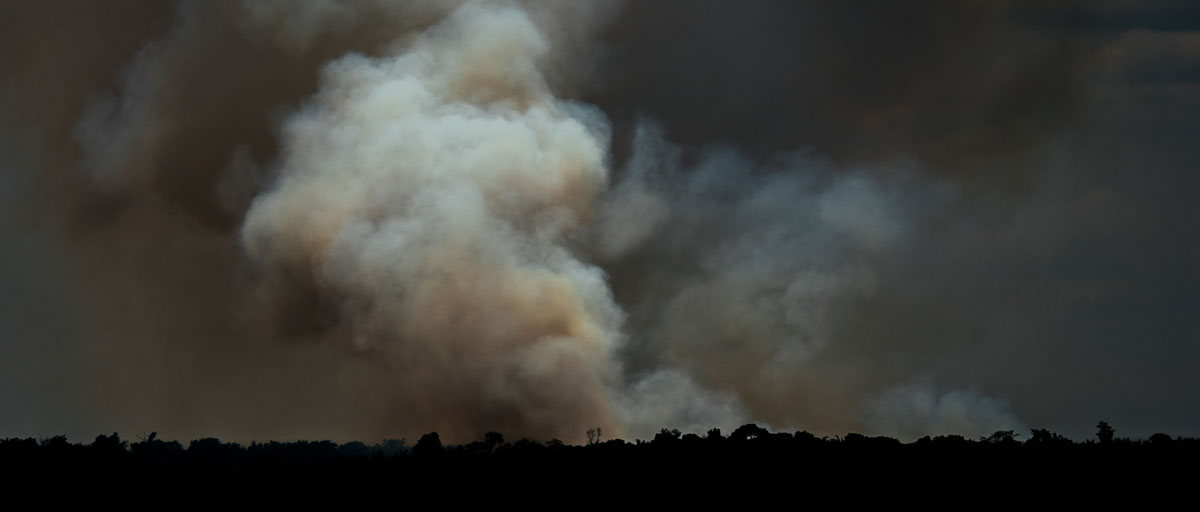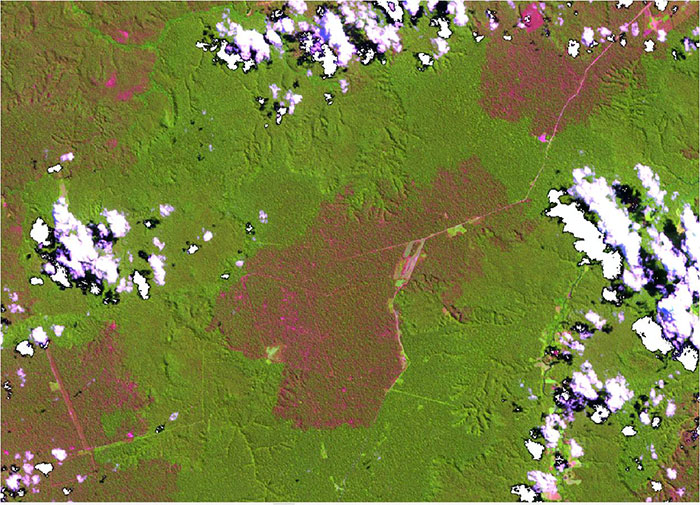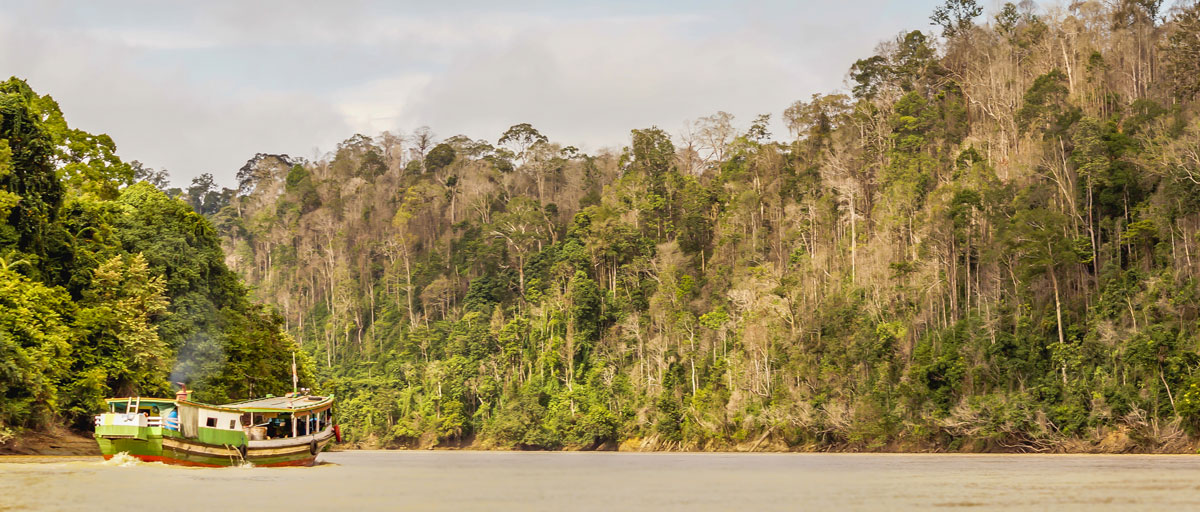
Smoke plume from one mega-fire during the 2015 drought in Eastern Amazonia. A new study reveals that carbon emissions from the Brazilian Amazon are increasingly dominated by forest fires during extreme droughts rather than by emissions from fires directly associated with deforestation. Photo: A. Ronan
Bildtext får vara max två rader text. Hela texten ska högerjusteras om den bara ska innehålla fotobyline! Photo: B. Christensen/Azote
Carbon emissions from the Brazilian Amazon
A different kind of fire
Forest fires during drought periods rather than deforestation fires increasingly dominate Amazonian carbon emissions
- Despite a strong decline in deforestation rates over the past 13 years, fire incidence increased by 36% during the 2015 drought alone
- Forest fires during drought years alone contributes on average with emissions of one billion ton of CO2 annually to the atmosphere, more than half those from old-growth forest deforestation
- Brazil has made substantive advances to report emissions from deforestation but needs urgently to focus on incorporating into estimates CO2 losses associated with fires unrelated to the deforestation process
Carbon emissions from the Brazilian Amazon are increasingly dominated by forest fires during extreme droughts rather than by emissions from fires directly associated with the deforestation process, according to centre researcher Ana Paula Aguiar. Together with colleagues from Brazil, the UK and US, she suggests that recurrent 21st century droughts may undermine achievements in reducing emissions from deforestation in this region. Their insights were recently presented in Nature Communications.
Deforestation down, forest fires up
The authors combined multiple sources of satellite data and greenhouse gas inventories to assess drought impacts on fire incidence and associated carbon emissions between 2003 and 2015 in the Brazilian Amazon. The authors find that despite a 76% decline in (clear-cut) deforestation rates over the past 13 years (for pasture conversion, for instance), fire incidence increased by 36% during the 2015 drought compared to the preceding 12 years. They estimate that forest fires during drought years alone, contributes on average with emissions of one billion ton of CO2 annually to the atmosphere, which are more than half those from old-growth forest deforestation.
Although Brazil has made substantive advances to curb and report emissions from deforestation, it also needs urgently to focus on measures to halt the increase in forest fires and incorporating the associated emission estimates in the reports.
Ana Paula Aguiar, co-author
According to Luiz Aragão, lead author of the study and a scientist from the Brazilian National Institute for Space Research (INPE), this is the first time that scientists could clearly demonstrate how forest fires can become widely spread during recent droughts and how much they influence Amazonian carbon emissions. He emphasizes that, the suite of satellites currently in operation allows the retrieval of data on current climate, atmospheric carbon content and the status of terrestrial ecosystems.
"This study is important because some observations and models indicate that the intensity and frequency of droughts in Amazonia may increase as a consequence of climate change and deforestation, therefore increasing the incidence of fires," says Dr. Aragao. This can risk the stability of forest carbon stocks and undermining the biodiversity co-benefits achievable in carbon conservation schemes, such as reducing emissions from deforestation and forest degradation (REDD+).
The conclusions of the study highlight that, although Brazil has made substantive advances to report emissions from deforestation, it also needs urgently to focus on incorporating CO2 losses associated with fires unrelated to the deforestation process.

Landsat 8 OLI (Operational Land Imager) image retrieving kilometres of burned forests (magenta colour tones) spread across old-growth forests (green colour tones) in Eastern Amazonia. White colours in the image correspond to clouds. Source: U.S. Geological Survey’s Earth Explorer Platform
The way forward
Ana Paula Aguiar, who was also an author of the Third Brazilian Communication to the UNFCCC (one of the responsible for the greenhouse gas emission inventory for the Forest and Land use sector) and contributes in the Technical Group about REDD+ organized by the Environment Ministry, explains that the Brazilian Government has been discussing how to incorporate old-growth forest fire emissions in the official estimates.
"It was not included yet due to uncertainties that needed to be further understood, such as the actual percentage of the biomass lost in each fire event, and mainly the process of carbon uptake due to forest recovery after the fire - as they need to report net emissions, not only the gross estimates."
But the current results summed to the full body of research being conducted at INPE and partner institutions - combining field data, remote sensing and computational models - are essential to advance in this needed direction.
"The good news is that, as a result of all these efforts, soon INPE will include old-growth forest fires in their operational greenhouse emission estimates system," she says, referring to the INPE-EM system (INPE - Emission Model, inpe-em.ccst.inpe.br), in which she and Dr. Aragao are also key contributors.
Since 2012, the system generates annual estimates of emissions of greenhouse gases derived from clear-cut deforestation and secondary vegetation dynamics, based on INPE’s monitoring systems (PRODES, TerraClass, DETER/DEGRAD).
"It is crucial that governments are aware of these values to propose realistic and effective solutions to maintain low deforestation levels, find new practices of land management and curb fire incidence. These actions will be of upmost importance for reducing future carbon emissions from the Brazilian Amazon," Aguiar and her colleagues conclude.
Methodology
The authors analyzed 13 years of monthly time-series (2003- 2015) of sea surface temperature anomalies (SSTA) indices, combined with a suite of satellite-derived rainfall, active fire detections, atmospheric carbon monoxide (CO), annual deforestation and burned area data for the Brazilian Amazon. The intensity of fire incidence was calculated using active fire pixels or hot pixels data, available from the INPE’s Center for Weather Forecasting and Climate studies (CPTEC) fire monitoring system. For mapping burn scars, the authors follow the methodology described by Anderson et al. (2015). The annual cumulative deforested area from 2003 to 2015 was obtained from INPE’s PRODES system. The inter-annual variability of Amazonian biomass burning emissions was analysed using the record of carbon monoxide (CO) measurements from the MOPITT (Measurements of Pollution in the Troposphere) satellite instrument. Based on these data sources, the authors estimated the gross CO2 emissions from forest fires for the whole 2003-2015 period, compared to the gross clear cut deforestation, obtained from report on annual estimates of greenhouse gas emissions developed by Brazilian’s Ministry of Science Technology and Innovation.
Aragão et al. (2018) 21st Century drought-related fires counteract the decline of Amazon deforestation carbon emissions. Nature Communications. DOI: 10.1038/s41467-017-02771-y
Ana Paula Aguiar acts as the SRC liaison person to the The World in 2050 project, a global research initiative in support of a successful implementation of the United Nations’ 2030 Agenda. Since her PhD, her research focused on the use of models and scenarios as tools to understand diverse land change processes (deforestation, agricultural expansion/intensification, desertification). Aguiar has pioneered the application of back-casting to discuss pathways to a sustainable future in the Brazilian Amazon at multiple scales.









